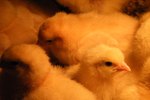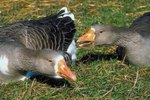
The word "peacock" is often used to describe males and females, but females are actually peahens, offspring are peachicks and peafowl is all-encompassing; peacocks technically are just the boys. There are three species of peafowl: Pavo cristatus (Indian or blue peafowl), Pavo muticus (green peafowl) and Afropavo congensis (Congo or African peafowl). Humans have co-existed with peafowl for millennia, yet scientists continue to discover new information in an effort to broaden our understanding of these birds.
Peacock Basics
Native to India, peafowl are polygamous. Peahens alone shoulder the duties of building nests on the ground, egg laying, four weeks of incubation and raising chicks. Peachicks are precocial; they can function at hatching, but they need protection. At 2 weeks old, peachicks can flap into a tree. At 4 weeks, chicks will have the distinctive head crest and at 2 months will be adult-sized. Peafowl eat grain, fruits, small reptiles and insects.
Darwin and Peacocks
Imagine Charles Darwin being so confounded by peacock tails he wrote a note to American botantist Asa Gray saying: "The sight of a feather in a peacock’s tail, whenever I gaze at it, makes me sick!" Darwin just couldn't figure out how that splendid tail fit his idea of survival of the fittest. Darwin concluded the large, ornate tail was a handicap to the male. He ultimately decided peacock tails telegraphed important information to peahens, coining the term sexual selection.
New Tail Research
Continued research on peacock tails generated conflicting conclusions. In 2013, evolutionary biologists, using eye tracking technology, reported peahens were not blinded by love of eye spots on peacock tails. Peahens were attracted to lower feathers under the showy display. Twelve wild peahens were fitted with headgear containing two cameras. One camera recorded information from hen eyes, the other recorded the scene in front of females. Combining wireless feeds from cameras led researchers to the discovery. Going forward, researchers will use eye-tracking devices on peacocks as they view peahens. Researchers will also alter the lower peacock tail feathers to try and determine exactly what peahens respond to during courtship displays.
White vs. Albino
White peacocks (Pavo cristatus mut. alba) are not albinos, but rather a subspecies of blue peacocks (Pavo cristatus) created by a genetic mutation. White peacocks have white plumage, blue eyes and can mate to create white offspring. Researchers note the feather structure in Pavo cristatus mut. alba is exactly like the structure in Pavo cristatus; only the color is different. Albino peacocks have a weaker feather structure and pink eyes. These birds do not produce enough melanin, one of the most common components of pigmentation in birds. Albino peacocks, even if successful at mating, would not automatically produce white offspring.
References
- Smithsonian National Zoological Park: Meet Our Animals: Indian Peafowl
- Darwin Correspondence Project: The correspondence of Charles Darwin, Volume 8: 1860
- Charles Darwin and Evolution: Sexual Selection
- Science Direct: Animal Behaviour: Peahens Do Not Prefer Peacocks with More Elaborate Trains
- Science Direct: Animal Behaviour: Peahens Prefer Peacocks Displaying More Eyespots, But Rarely
- Washington Post: Eye-trackers Help Scientists Study How Peacock Tails Lure Peahens
- Journal of Structural Biology: Keratin homogeneity in the tail feathers of Pavo cristatus and Pavo cristatus mut. alba
- The Cornell Lab of Ornithology: All About Birds: Feather Color
- Birding Magazine: Disease and Disorder: Color Abnormalities in Birds: A Proposed Nomenclature for Birders
Resources
- Los Angeles Times: L.A. Then and Now: Peacocks are One of Arcadia Founder's Legacies
- Peafowl in Arcadia: Living With Arcadia's Wild Birds
- PBS: NOVA: Creature Courtship
- YouTube: Peacock Dance
- Jessica Yorzinski: Evolutionary Biologist
- Wired: What a Peahen Really Watches When a Peacock Tries to Impress Her
Photo Credits
-
Jupiterimages/Photos.com/Getty Images




